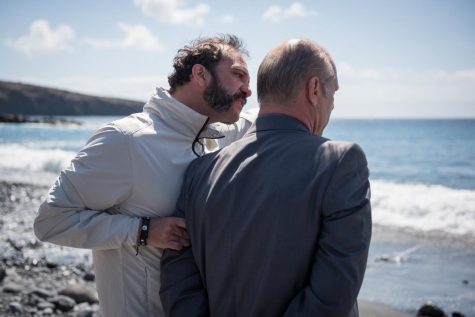“Portrait Of A Lady On Fire” Paints a Beautiful and Symbolic Love Story
“Portrait of a Lady on Fire,” originally released in France, stars Adèle Haenel (left) and Noémie Merlant (right). (Courtesy of Facebook)
February 19, 2020
“Portrait of A Lady on Fire” is a quiet yet captivating story of star- crossed lovers in 18th century France. As the winner of the Cannes Film Festival Award for Best Screenplay, among several other awards and nominations, this independent film lives up to the divinely aesthetic camera shots and poetic storyline typical of its genre.
It all begins when a troubled Héloïse (Adèle Haenel), still mourning the death of her sister, is fated to be married off to a man in Milan whom she has never met. Her mother hires Marianne, a female painter, to create a portrait of Héloïse without her knowing. She rejects the marriage and the idea of posing for a portrait that seems to seal her fate.
The film takes a slow pace at its beginning with drawn-out scenes of the two women walking the charming coastline with little to no dialogue. There are primarily shots of the painter stealing glances at the elusive beauty, unhappy in this somber state of life. The film does a great job of adding symbolism that is important later on in the movie.
The first 20 minutes may fail to hold your attention. However, there is a turning point once Marienne begins to reveal her observations of Héloïse. In return, Héloïse points out the habits of Marianne, and thus the audience then understands, just as the painter has been observing the painted, so has Héloïse been studying her visitor.
There is a brilliant use of symbolism throughout the movie, fire and the coastline being the primary ones, that make the film’s slow pace worth it in the end. It is at the coast where Héloïse finally feels liberty, and where the two find freedom together. Fire is a symbol of the attraction between the pair, demonstrating its beauty and destructiveness. The relationship between the women is parallel to how the film uses fire as a chaotic but symbolic element.
The innocent story of love between Héloïse and Marianne was refreshing and heartbreaking at the same time. The directors did not over sexualize the same sex relationship as has been done with other love stories between two women. The two were simply free-spirited and learned and taught one another throughout the film.
Feminine strength, determination and the capacity for passion shines through in this story. This is especially notable in the narrative of Marianne, who was kicked out of school as a young girl for drawing in class and then went on to become a true artist.
She defies standards for women of the time, remarking how she still paints nude models of both sexes even though it is prohibited for women. Her determination to destroy pieces until she can find the right angle is an inspiring characteristic that a more action-packed film may have neglected to focus on.
Closing the movie is a scene where Héloïse is watching an orchestra in the future in an epic catharsis, listening to the piece that reminds her of Marianne and their time together.
Haenel’s acting is extremely moving and emotional, and it is an extraordinary way to end the film as the viewer is given time to listen and reflect on the emotions of the story at the same time as Héloïse.
There is a satisfying ending to this story. All of the subtle symbols that hinted towards their connection throughout the movie are tied up in a perfect package for a dramatic ending.












If you want a picture to show with your comment, go get a gravatar.